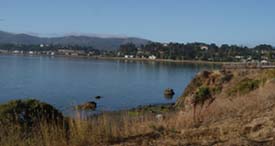San Francisco Bay and Richardson Bay, California

Richardson Bay is a shallow, ecologically rich arm of San Francisco Bay managed under a Joint Powers Agency of four Northern California cities. The Richardson Bay Sanctuary was purchased in the early 1960s by the Audubon Society. Richardson Bay is considered one of the most pristine estuaries on the Pacific Coast in spite of its urbanized periphery, since it supports extensive eelgrass areas and sizable undisturbed intertidal habitats. It is a feeding and resting area for a panoply of estuarine and pelagic birds, while its associated marshes and littoral zones support a variety of animal and plant life.
Richardson Bay has been designated as an Important Bird Area (or IBA), based upon its large number of annual bird visitors and residents, its sightings of California clapper rail and its strategic location in the flyway. The bay's waters are subject to a "no discharge" rule to protect the elaborate and fragile ecosystems present, including a complex fishery, diverse mollusk populations and even marine mammals such as the harbor seal.
Richardson Bay is an important ecological area being managed by the Audubon Society as the Richardson Bay Sanctuary. There are significant resources, marsh birdlife, mammalian species and marsh plants.
Birds are abundant in Richardson Bay, with over one million migratory visitors each winter. Richardson Bay has been dedicated as a Hemispheric Reserve of the Western Shorebird Network. Migrating birds that winter regularly at Richardson Bay include Least sandpiper, Western sandiper, Spotted sandpiper, American avocet, Dunlin, Marbled godwit, Greater yellowlegs, Willet, Long-billed curlew, and Dowitchers. A special resident of Bothin Marsh is the California clapper rail, a non-migratory endangered species.
Common year-round residents of the Richardson Bay Sanctuary include Great blue heron, Snowy egret, Great egret, mallard, Red-tailed hawk, Turkey vulture, Killdeer, Western gull, Mourning dove, Rock dove, and Anna's hummingbird. Other common residents include the Scrub jay, American crow, Chestnut backed chickadee, Common bushtit, Bewick's wren, House sparrow, Red-winged blackbird, House finch, Song sparrow, and California towhee.
Fishery characteristics of Richardson Bay include a herring fishery and oyster beds. The herring population is in a downward trend, although not from excessive fishing pressure with the net techniques in use, but rather from ocean environmental factors. Herring spend most of their lives in the open ocean and come to Richardson Bay and other estuaries for winter spawning in the shallow protected waters. In Richardson Bay their eggs atttach to assorted surfaces such as eelgrass, piers, or rip-rap.
Regarding the oyster beds, an experimental program is underway as of 2006, in which foreign oyster shells (biologically inert) are bagged and emplaced in underwater locations to serve as larval substrates, in order to assist the native oysters in propagating. Locally oysters are preyed upon by the bat ray and certain crabs.
Flora include intertidal and upland species. Probably the most notable feature is the extensive eelgrass population at the tideland perimeter of Richardson Bay. This eelgrass occurrence in Richardson Bay is considered one of the most sizeable stands in Northern California, and it is also currently undergoing restoration, leading to further extent of this habitat. There is also an extensive pickleweed habitat at the western end of the bay, where many acres of mudflat areas are exposed to shorebirds at low tide at the efflux of Pickleweed Creek. Upland plants found at the perimeter of Richardson bay include toyon, coast live oak, California bay, and native California bunch grasses.











